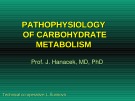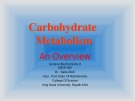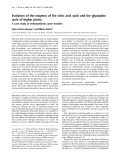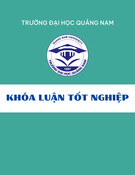Carbohydrate Metabolism An Overview
(
General Biochemistry-II (BCH 302 Dr . Saba Abdi Asst . Prof. Dept. Of Biochemistry College Of Science King Saud University. Riyadh.KSA
Major Pathways
1.
3.
4.
Glycolysis Citric acid cycle 2. Gluconeogenesis Glycogen metabolism a( Glycogenesis )b( Glycogenolysis
)
2
Saba Abdi
I. Glycolysis (Embden Meyerhof
Pathway):
A. Definition: 1. Glycolysis means oxidation of glucose to give pyruvate (in the
B. Site: cytoplasm of all tissue cells, but it is of physiological importance in:
presence of oxygen) or lactate (in the absence of oxygen).
1. Tissues with no mitochondria: mature RBCs, cornea and lens.
2. Tissues with few mitochondria: Testis, leucocytes, medulla of the
kidney, retina, skin and gastrointestinal tract.
3. Tissues undergo frequent oxygen lack: skeletal muscles especially
3
Saba Abdi
during exercise.
C. Steps: Stages of glycolysis 1. Stage one (the energy requiring stage): a) One molecule of glucose is converted into two molecules of
glycerosldhyde3phosphate.
b) These steps requires 2 molecules of ATP (energy loss)
2. Stage two (the energy producing stage(: a) The 2 molecules of glyceroaldehyde3phosphate are converted into
pyruvate (aerobic glycolysis) or lactate (anaerobic glycolysis(.
4
Saba Abdi
b) These steps produce ATP molecules (energy production).
5
Saba Abdi
) Energy Investment Phase (steps 1-5
Fig. 9.9a
6
Saba Abdi
Fig. 9.9b
) Energy-Payoff Phase (Steps 6-10
Energy production of glycolysis:
ATP produced
ATP utilized
Net energy
2 ATP
In absence of oxygen (anaerobic glycolysis)
2ATP From glucose to glucose 6p. From fructose 6p to fructose 1,6 p.
6 ATP Or 8 ATP
In presence of oxygen (aerobic glycolysis)
2ATP From glucose to glucose 6p. From fructose 6p to fructose 1,6 p.
4 ATP (Substrate level phosphorylation) 2ATP from 1,3 DPG. 2ATP from phosphoenol pyruvate 4 ATP (substrate level phosphorylation) 2ATP from 1,3 BPG. 2ATP from phosphoenol pyruvate. + 4ATP or 6ATP (from oxidation of 2 NADH + H in mitochondria).
7
Saba Abdi
E. oxidation of extramitochondrial NADH+H+: 1. cytoplasmic NADH+H+ cannot penetrate mitochondrial membrane, however, it can be used to produce energy (4 or 6 ATP) by respiratory chain phosphorylation in the mitochondria. 2. This can be done by using special carriers for hydrogen of NADH+H+ These carriers are either dihydroxyacetone phosphate (Glycerophosphate shuttle) or oxaloacetate (aspartate malate shuttle). a) Glycerophosphate shuttle: 1) It is important in certain muscle and nerve cells. 2) The final energy produced is 4 ATP. 3) Mechanism:
The coenzyme of cytoplasmic glycerol3 phosphate dehydrogenase
is NAD+.
The coenzyme of mitochodrial glycerol3phosphate dehydogenase is FAD. Oxidation of FADH, in respiratory chain gives 2 ATP. As glycolysis gives 2 cytoplasmic NADH + H+ (cid:0) 2 mitochondrial FADH, 2 x 2
Saba Abdi
8
= 4 ATP.
ATP (cid:0) b) Malate – aspartate shuttle: 1) It is important in other tissues patriculary liver and heart. 2) The final energy produced is 6 ATP.
Differences between aerobic and anaerobic glycolysis:
Aerobic Anaerobic
1. End product Pyruvate Lactate
2 .energy 6 or 8 ATP 2 ATP
3. Regeneration of Through Lactate
NAD+ Through respiration chain in mitochondria formation
4. Availability to TCA
in mitochondria Not available as lactate is cytoplasmic substrate
9
Saba Abdi
Available and 2 Pyruvate can oxidize to give 30 ATP
Importance of lactate production in anerobic
glycolysis:
1. In absence of oxygen, lactate is the end product of glycolysis: Pyruvate (cid:0)
Glucose (cid:0)
Lactate
2. In absence of oxygen, NADH + H+ is not oxidized by the
respiratory chain.
3. The conversion of pyruvate to lactate is the mechanism for
regeneration of NAD+.
4. This helps continuity of glycolysis, as the generated NAD+ will be
10
Saba Abdi
used once more for oxidation of another glucose molecule.
Substrate level phosphorylation: This means phosphorylation of ADP to ATP at the reaction itself .in
glycolysis there are 2 examples:
1.3 Bisphosphoglycerate + ADP 3 Phosphoglycerate + ATP
Phosphoenol pyruvate + ADP Enolpyruvate + ATP I. Special features of glycolysis in RBCs: 1. Mature RBCs contain no mitochondria, thus:
a) They depend only upon glycolysis for energy production (=2 ATP).
b) Lactate is always the end product.
2. Glucose uptake by RBCs is independent on insulin hormone.
11
Saba Abdi
3. Reduction of methemoglobin: Glycolysis produces NADH+H+, which used for reduction of methemoglobin in red cells.
Biological importance (functions) of glycolysis: 1. Energy production: a) anaerobic glycolysis gives 2 ATP. b) aerobic glycolysis gives 8 ATP. 2. Oxygenation of tissues: Through formation of 2,3 bisphosphoglycerate, which decreases the affinity of Hemoglobin to O2. 3. Provides important intermediates: a) Dihydroxyacetone phosphate: can give glycerol3phosphate, which is used for synthesis of triacylglycerols and phospholipids (lipogenesis). b) 3 Phosphoglycerate: which can be used for synthesis of amino acid serine. c) Pyruvate: which can be used in synthesis of amino acid alanine. 4. Aerobic glycolysis provides the mitochondria with pyruvate, which gives acetyl CoA Krebs' cycle.
12
Saba Abdi
Reversibility of glycolysis (Gluconeoqenesis): 1. Reversible reaction means that the same enzyme can catalyzes the
reaction in both directions.
2. all reactions of glycolysis except 3 are reversible.
3. The 3 irreversible reactions (those catalyzed by kinase enzymes) can be
reversed by using other enzymes.
(cid:0) Glucose6p Glucose
F1, 6 Bisphosphate Fructose6p
(cid:0) (cid:0) Pyruvate Phosphoenol pyruvate
4. During fasting, glycolysis is reversed for synthesis of glucose from non
carbohydrate sources e.g. lactate. This mechanism is called:
13
Saba Abdi
gluconeogenesis.
–
–
• As pyruvate enters the mitochondrion, a multienzyme complex modifies pyruvate to acetyl CoA which enters the Krebs cycle in the . matrix A carboxyl group is removed as CO2 . A pair of electrons is transferred from the remaining two-carbon fragment to NAD+ to . form NADH
–
The oxidized fragment, acetate, combines with coenzyme A to form acetyl CoA
.
14
Saba Abdi
Fig. 9.10
Kreb Cycle
15
Saba Abdi
Electron Transport Chain
16
Saba Abdi
Summary
Mitochondrion
Electrons carried in NADH
Pyruvic acid
Electrons carried in NADH and FADH2
Glucose
Electron Transport Chain
Glycolysis
Krebs Cycle
Mitochondrion
Cytoplasm
17
Saba Abdi
Total energy yield
• • •
Glycolysis 2 ATP Krebs Cycle 2 ATP ETC 32 ATP
•
Total 36 ATP
18
Saba Abdi
Glycogen Metabolism
Py r o p h o s ph at as e
2 Pi
PPi
UDP Gluc o s e
Gly c og e n (Gluc os e ) n
UT P
UDP Glu c o s e Py r o ph os ph or y las e
Glyc o g e n S y n t h a s e
UDP
G luc o s e 6 P
Gluc o s e 1 P
Gly c og e n (G luc o s e ) n+1
Ph o s p h o g luc o m u t as e
Glyc og e n Ph os ph or ylas e
Gly c o ge n
Pi
( Gluc o s e ) n
Saba Abdi
19
: Glycogenesis
•
•
Glycogenesis is the formation of glycogen from glucose. Glycogen is synthesized depending on the demand for glucose and ATP )energy(. If both are present in relatively high amounts, then the excess of insulin promotes the glucose conversion into glycogen for storage in liver and muscle cells . In the synthesis of glycogen, one ATP is required per glucose incorporated into the polymeric branched structure of glycogen. actually, glucose-6-phosphate is the cross-roads compound. Glucose-6-phosphate is synthesized directly from glucose or as the end product . of gluconeogenesis
20
Saba Abdi
Glycogenolysis
glycogenesis
In glycogenolysis, glycogen stored in the liver and muscles, is converted first to glucose-1- phosphate and then into glucose-6-phosphate. Two hormones which control glycogenolysis are a peptide, glucagon from the . pancreas and epinephrine from the adrenal glands Glucagon is released from the pancreas in response to low blood glucose and epinephrine is released in response to a threat or stress. Both hormones act upon enzymes to stimulate glycogen phosphorylase to begin glycogenolysis and inhibit glycogen synthetase )to stop (. 21
Saba Abdi
.
•
•
Glycogen is a highly branched polymeric structure containing glucose as the basic monomer. First individual glucose molecules are hydrolyzed from the chain, followed by the addition of a phosphate group at C-1. In the next step the phosphate is moved to the C-6 position to give glucose 6-phosphate, a cross road . compound Glucose-6-phosphate is the first step of the glycolysis pathway if glycogen is the carbohydrate source and further energy is needed. If energy is not immediately needed, the glucose-6-phosphate is converted to glucose for distribution in the blood to various cells such as Saba Abdi . 22
brain cells





















